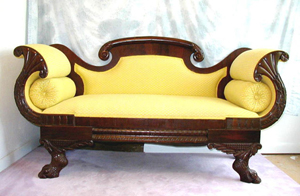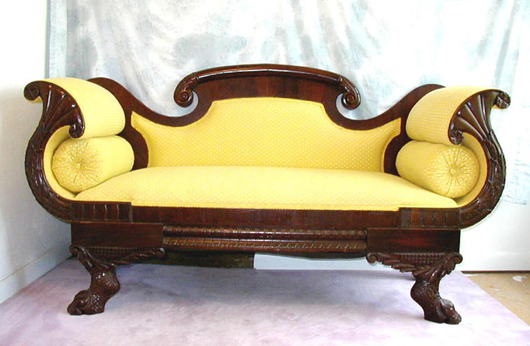
I get calls, letters and emails each month requesting information about a piece or a set of furniture. Most of the time I am more than happy to share any information I may have to enhance the inquirer’s relationship with a family treasure or new discovery. But there are times when I just don’t feel like the inquirer has met me halfway. Especially when the question starts out something like, “I have this old piece of furniture. It’s sorta tall but not real wide in the middle. It has a real dark color and you can hardly see all the stuff in it. My mother said it has been in our family forever. Can you tell me how old it is, who made it and what it is worth?”
That’s not quite enough to go on. It’s like telling the mechanic the car just doesn’t feel right or informing the doctor that it hurts real bad but you can’t tell where it hurts. There is a need for specific information in all these cases. I don’t know much about cars and have never had a real good rapport with doctors, but I do know there is a method by which a piece of furniture can be described. If most of the blanks are filled in, the rest of the information can be ferreted out somehow.
It is a step-by-step process that proceeds logically from one area to the next. In trying to describe a piece of furniture the first and most important step is to identify what the piece is—in other words the FORM.
FORM
Form identification starts with the really simple stuff like chair, table, couch, cabinet, bookcase, dresser, chest, etc. But it gets more difficult from there. There are very specific types and classes of forms that lead to clearer identification. For example just take a look at “table.” How many different types of tables can you name? Take 15 seconds and name as many types of tables as you can. Done? If you didn’t name at least 10 you are not paying attention. How about dining, work, tray, tea, coffee, cocktail, lamp, end, console, foyer? And each type that you named has specific attributes that make it that type of table. Just naming the type of table already is a great step to further identification by ruling out all the other thousands of types of tables. And each type table you thought of has even more specific variations that narrow the identification process even further.
For example, try thinking about just dining tables. Types and variations that come quickly to mind are pedestal, extension, draw, tilt-top, refectory, drop leaf, gateleg and combinations thereof. Each one generates a mental picture of a specific table that generally is not to be confused with another, if you have the right word with the right picture. But that is just a matter of training.
If you get the form right the next level of description is to be found in the STYLE.
STYLE
Style, in essence, is how the form was executed. A Chippendale table is certainly different from a Renaissance Revival table. The two styles have unmistakably different approaches to providing a level, stable surface upon which to eat. The Chippendale table will be more delicate and bring elements of Rococo to mind while the Renaissance Revival table will be more architectural and dense. There is no intermixing of the two, no gray area or fuzzy line of demarcation. That is not true of all styles but in most cases a clear enough distinction between styles can be found to create the proper mental image, with a little practice. Almost any antiques book will have a rough guide to styles.
Now that the FORM and the STYLE have been locked in what is the next step in the descriptive process? The AGE.
AGE
Most styles can be associated with a certain period of time. The name of the style is normally the first clue to the period since most early styles were named after a monarch of the time or a reasonably recent one at any rate. Obvious names include Queen Anne, Georgian, Jacobean, Elizabethan and William and Mary. If you know some royal history you know the period. Other style names are not quite so obvious but can be associated with a specific period such as Chippendale, Victorian, Federal, Empire and Arts and Crafts. But if you know the style do you then know the age? Of course not. Queen Anne is a good example. The new style began to take hold in England as early as 1715 but did not really reach the American colonies until 1725. The same is true with Chippendale. Thomas Chippendale was a force in English furniture in the 1740s and 1750s, but his style did not take hold in the Colonies until nearly 1760. And when it did it was not the up-to-date Chippendale of England. It was a more conservative approach that still used the ball and claw foot on the cabriole leg, something that was so out date in 1754 when Chippendale published his famous book that he did not even illustrate the foot.
And then there is the problem of reproductions and revivals. Most of the major styles have had a revival at one time or another and some of them are quite good. The longest continuously running revival is the Colonial Revival which began in the late 19th century and by some accounts is still on a roll.
You have to do better than simple style to determine an age for a piece of furniture. You have to look at construction techniques of the period. And construction materials can make a difference too. A Chippendale chair that reveals a plywood splat is certainly not an 18th century chair. Neither is one that is assembled using round dowels, nor one that is made of gum (wood) with a dark mahogany dye stain in it. Determining the age is probably the most complicated of all the descriptive categories and requires the most study.
WOOD
The next detail you need to know about the piece is the WOOD from which it is made. Identifying wood is perhaps the area that many collectors are weakest in. But it really can be fairly simple.
Wood is most easily identified by its texture. Coarse grain woods have deep crevices in the grain that are evident to the touch and are all hardwoods. Common coarse grain woods used in furniture are oak, ash, hickory, pecan, chestnut and elm. Medium grain woods have a finer texture but still have prominent open spaces. The most commonly used are walnut, mahogany and butternut or white walnut. The last type wood is the smooth or closed grain wood. This includes cherry, maple, birch, polar, gum, pine and beech. The wood is smooth and has no obvious open spaces in the grain.
If you can identify the relative coarseness of the grain you can boil your choice of woods down to the small handful of candidates commonly used in furniture production from that class.
FINISH
The final area of descriptive detail is the FINISH. Is it painted or does it have a transparent finish? If it is painted does it look original to the piece? If it is transparent does it appear to be a penetrating finish such as oil that leaves no apparent surface film or is it a surface finish that provides the piece with a protective skin? If it has a surface film that usually means the finish is shellac, lacquer, varnish or urethane. A few simple tests with solvents will help determine which it is among the possible candidates. With a cotton swab apply a small amount of denatured alcohol in an inconspicuous spot. After 30 seconds test the spot with your finger. If the finish is sticky it is shellac. If it is still firm try the same test with lacquer thinner. If it’s sticky after 30 seconds the finish is lacquer. If not it is an oil based varnish or urethane or perhaps a water based urethane. In any event other than when the finish is shellac, you can be pretty sure that the finish is one from the 20th century or later, either original or overcoated.
Don’t you wish you could get that much detail in an auction catalog?
___
Send comments, questions and pictures to Fred Taylor at P.O. Box 215, Crystal River, FL 34423 or email them to him at info@furnituredetective.com.
Visit Fred’s website at www.furnituredetective.com. His book How To Be a Furniture Detective is available for $18.95 plus $3 shipping. Send check or money order for $21.95 to Fred Taylor, P.O. Box 215, Crystal River, FL 34423.
Fred and Gail Taylor’s DVD, Identification of Older & Antique Furniture ($17 + $3 S&H) is also available at the same address. For more information call 800-387-6377 (9 a.m.-4 p.m. EDT, M-F only), fax 352-563-2916, or info@furnituredetective.com. All items are also available directly from his website.
ADDITIONAL IMAGE OF NOTE



